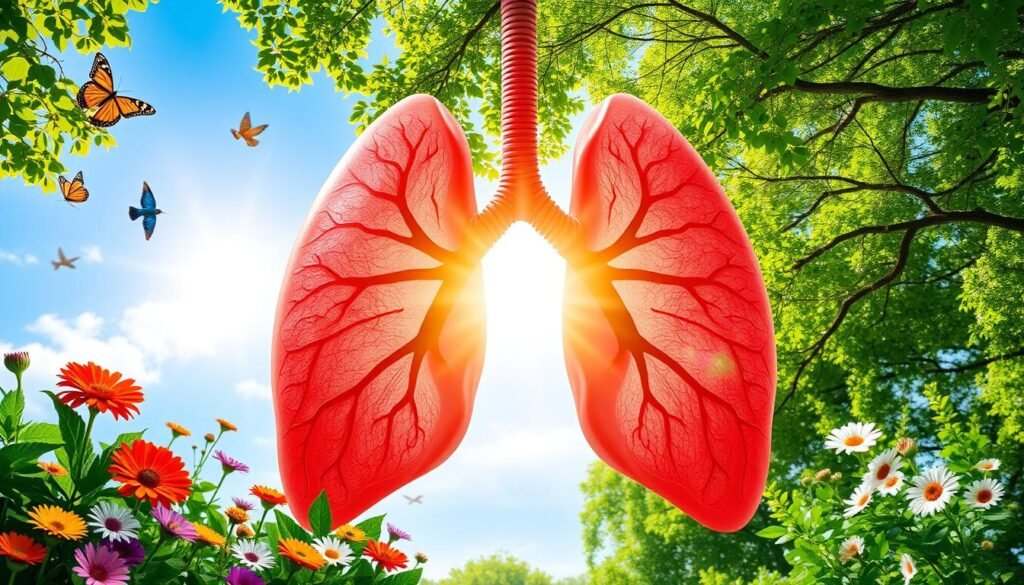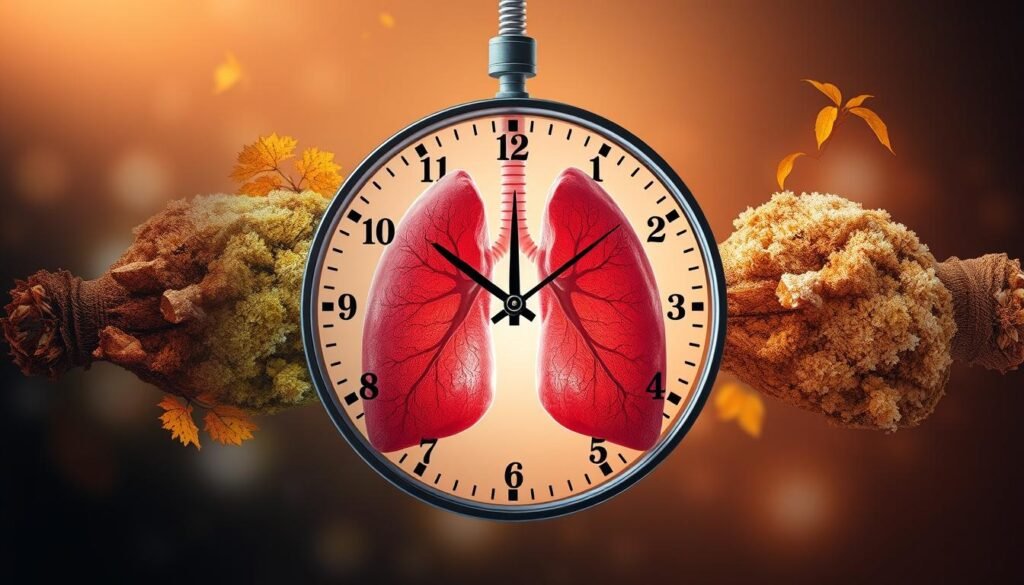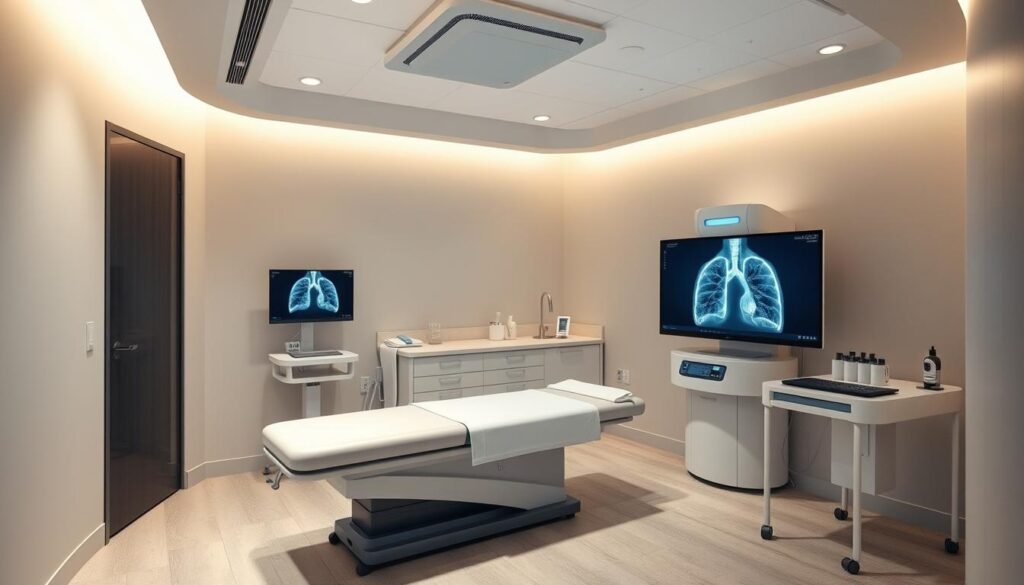Did you know about 85% of lung cancer cases come from smoking? This shows how vital it is to quit. Quitting can greatly lower your chances of getting lung cancer and other diseases from smoking. Starting to avoid Cancer Prevention involves knowing how bad tobacco is. Even if you’ve smoked a lot, stopping can make your health much better over time.
When people quit smoking, they see health benefits right away. Health keeps getting better, both soon after quitting and years later. It’s important for those who’ve stopped smoking to get checked for lung cancer often. This can help catch any problems early. To learn more about why these checks are important, check out this informative article. Knowing more and taking action are key steps to getting healthier.
Key Takeaways
- 85% of lung cancer cases are attributed to smoking.
- Quitting before age 40 can decrease premature death from smoking-related diseases by 90%.
- Regular screenings are recommended for former heavy smokers.
- Cessation of smoking can lower lung cancer risk by 50%-80%.
- Living with a smoker increases the risk of lung cancer or heart disease from secondhand smoke.
- At least a 40% reduction in cancer death risk is possible after quitting smoking post-diagnosis.
Understanding the Impact of Smoking on Health
Smoking greatly affects your health, especially your chances of getting lung cancer. About 85% of lung cancer cases are due to smoking. The harmful substances in tobacco smoke change lung tissue, making cancer more likely. It’s important to know about this to improve lung health and lower smoking-related diseases.
Link Between Smoking and Lung Cancer
The more and longer you smoke, the higher your risk of lung cancer becomes. For example, men who smoke more than 30 cigarettes a day have very high odds of getting Squamous Cell Carcinoma (103.5), Small Cell Lung Cancer (111.3), and Adenocarcinoma (21.9). Women have similar risks with odds of 62.7, 108.6, and 16.8 for the same cancers. Even if you quit, the risk lingers for years. This shows the lasting harm smoking can do to your lungs. For details on the impact of smoking over the years, check out this link.
Other Health Risks Associated with Smoking
Smoking isn’t just about lung cancer. It leads to heart disease, emphysema, and COPD too. Non-smokers can also suffer from secondhand smoke, raising their lung cancer risk by about 30%. With smoking tied to a third of all cancer deaths in the US, stopping smoking is key for health.
Benefits of Quitting Smoking
Quitting smoking gives you many benefits that reach beyond just getting better health-wise. Right after you stop smoking, your body begins to heal. You’ll start seeing these benefits quickly, and they grow over time, leading to a healthier life without cigarettes.
Immediate Health Improvements
When you stop smoking, your body begins recovering from tobacco’s harmful effects. In just minutes, your heart rate and blood pressure start getting back to normal. Over the next few days, your blood flow gets better, and your lungs start working better. You’ll also notice these changes fast:
- More oxygen in your blood
- Less carbon monoxide in your body
- Better taste and smell
- Fewer lung infections
Long-Term Health Benefits
Stopping smoking has big benefits for your health over time. It can really change your life. You might still have some risk for lung cancer, but quitting smoking does lower the risk a lot. Staying smoke-free also lowers your risk for other cancers and makes your lungs healthier. Studies show that:
- People who quit before 40 cut their risk of lung cancer by up to 90%.
- Five years after quitting, your lung cancer risk drops a lot compared to if you had kept smoking.
- Even if you smoked a lot before, quitting can lower your lung cancer risk by 39% after five years.
The longer you stay away from cigarettes, the better it is for you. Living a healthy life adds to these benefits, making you feel even better.

| Time Frame | Health Improvement |
|---|---|
| 20 Minutes | Reduced heart rate and improved circulation |
| 12 Hours | Carbon monoxide levels normalize |
| 1 Year | Risk of heart disease cut in half |
| 5 Years | Significant drop in lung cancer risk |
| 10 Years | Lung cancer risk reduced by 50% compared to smokers |
Smoking Pack Years and Lung Cancer Risk
Understanding smoking pack years and lung cancer is key for health. It’s a way to measure how much someone has smoked. The more you smoke, the higher your risk of lung cancer and other health issues.
Defining Smoking Pack Years
Smoking pack years tell us about smoking exposure over time. It’s smoking one pack a day for a year. If you’ve smoked a pack a day for ten years, that’s ten pack years. This helps experts gauge tobacco exposure risks.
How Smoking Pack Years Influence Cancer Risk
More smoking pack years mean a higher cancer risk. Studies show big differences in lung cancer rates based on smoking history. More pack years, higher lung cancer risk. Data shows women are more at risk than men for the same smoking amount.
Statistical Insights from Epidemiological Studies
Research shows smoking causes about 85% of lung cancer cases. In 2024, lung cancer is expected to cause around 125,070 deaths in the U.S. Yet, over 80% who can get screened don’t know they can. Sadly, only 5% to 19% get screened for lung cancer. Understanding pack years helps doctors talk about screening and prevention better.
How Time Affects Lung Cancer Risk After Quitting
Quitting smoking majorly improves your health. It greatly cuts lung cancer risk within the first five years by about 39.1%. After that, the risk drops by half in 10 to 15 years. Since tobacco is a big cause of lung cancer, quitting gives ex-smokers hope.
Understanding the Timeline of Risk Reduction
Even years after quitting, risks of lung cancer need attention. Ex-smokers have three times the risk compared to non-smokers for 25 years. The CDC says smoking is behind up to 90% of lung cancer deaths. So, it’s key to know how time affects lung cancer risk after quitting.
Long-Term Benefits of Quitting Smoking
Quitting smoking brings long-term health gains. It means a lower risk of lung cancer and better survival rates. Studies show quitters live longer than those who keep smoking. Even people who’ve stopped for years see huge benefits to their health. Therefore, getting help to quit smoking is vital for a healthier future. Encouraging smoking cessation adds to these benefits, leading to better health outcomes.

Importance of Regular Cancer Screening for Ex-Smokers
For those who’ve stopped smoking, regular cancer screenings are crucial. They are at a higher risk for lung cancer. Adhering to Cancer Screening Recommendations, yearly screenings are advised for ex-smokers, particularly those who smoked heavily. Early detection through this approach increases survival chances.
Who Should Get Screened?
The American Cancer Society suggests annual lung cancer screenings for 50 to 80-year-olds. This is for those who smoked a lot or quit smoking but have a 20 pack-year history. A pack-year means smoking a pack a day for a year. Even those who quit over 15 years ago should get screened. Broader screening criteria could cut lung cancer deaths and add more years to lives.
What to Expect from Lung Cancer Screening
Low-dose computed tomography (CT) scans are used for screening. They’re effective. According to the National Lung Screening Trial (NLST), low-dose CT scans lower lung cancer deaths by 20% compared to chest x-rays. Screening detects lung cancer in 2-3% of high-risk individuals initially, and 1-2% in later checks. For those screened, surgery can often successfully treat early-stage lung cancer.

Air pollution, besides smoking, increases lung cancer risks. Lung cancer screening awareness underlines its importance for smokers and the role of prevention. Weighing lung cancer screening’s benefits against CT scan risks shows positive outcomes. Such screenings should be a regular practice.
For more info on lung cancer screening guidelines, people can look into the details. It helps understand health needs and risks fully.
Other Factors Influencing Lung Cancer Risk
There’s more to lung cancer risk than just if you’ve smoked or not. Your environment and your body’s history, like any Family History of Lung Cancer and Medical History, also matter. Knowing these can help figure out your risk and lead to actions that prevent cancer.
Environmental and Occupational Exposures
Many things in the environment can make lung cancer more likely. Being around harmful substances at work, especially carcinogens like asbestos and radon, is risky. Working with things like arsenic, beryllium, cadmium, and diesel exhaust increases lung cancer chances. Below is a chart that shows major environment-related lung cancer risks:
| Exposure Type | Description | Risk Factor |
|---|---|---|
| Asbestos | A naturally occurring fibrous mineral. | Increased risk of lung cancer, particularly for workers. |
| Radon | A radioactive gas from the soil that can build up inside houses. | It’s the second-biggest cause of lung cancer, mainly if you don’t smoke. |
| Secondhand Smoke | When you breathe in smoke from someone else’s cigarette. | It’s the third leading cause of lung cancer in the U.S. |
| Outdoor Air Pollution | Pollution from cars and factories. | This leads to 1% to 2% of lung cancer deaths. |
Family and Medical History
Having family members with lung cancer can increase your own risk. This is especially true for first-degree relatives. If you’ve had radiation therapy before or another lung cancer, you’re also more at risk. People who’ve had lung cancer should know they’re more likely to get it again, especially with a certain Family or Medical History.
Research Supporting Cessation and Screening
Many studies show the benefits of stopping smoking and getting checked for lung cancer regularly. Smoking causes about 90% of lung cancer cases. Knowing more about how smoking and lung cancer are linked, experts highlight the need for both past and current smokers to get screened.
Key Findings from Recent Studies
New research shows quitting smoking and early screening help improve lung cancer survival rates. The National Lung Screening Trial found a 20% drop in lung cancer deaths among those screened with low-dose CT scans, versus traditional X-rays. This fact points out the value of catching lung cancer early in people at high risk, like heavy smokers.
- Stopping smoking can greatly lower lung cancer risk in those who used to smoke by 20% to 90% compared to smokers.
- The 5-year survival rate for lung cancer in seniors aged 65 and older who quit smoking is 70%, but only 33% for smokers.
- If someone with early lung cancer keeps smoking, their risk of the cancer coming back jumps by 86%.
The Role of Screening in Early Detection
Finding lung cancer early through screening means better chances of survival. There are about 5 million smokers in the U.S. who could be screened. Early lung cancer screening gets support from the Centers for Medicare and Medicaid Services. They now require advice on stopping smoking before screening with CT scans. Many who get screened for lung cancer also want to quit smoking, with 67% to 95% showing interest.
| Study Findings | Effect of Quitting Smoking | 5-Year Survival Rates |
|---|---|---|
| NLST Results | 20% reduction in mortality rate | N/A |
| Former Smokers vs. Current Smokers | Risk reduction of 20% to 90% | 70% for quitters with early-stage non-small cell lung cancer |
| Recurrence Risk in Early-Stage Lung Cancer | 86% increased risk for smokers post-diagnosis | 33% for those continuing smoking |
Deep research into how stopping smoking, screening, and survival rates are linked helps health experts give good advice. This knowledge encourages a proactive health attitude in smokers and ex-smokers. It leads to better outcomes and life quality.
Public Health Awareness and Smoking Cessation Programs
Public health efforts are key to lowering smoking rates and teaching about lung cancer risks. Smoking Cessation Programs help those who want to stop smoking. They offer resources like hotlines, counseling, and plans to help people succeed.
Resources for Support and Guidance
There are many resources to help people quit smoking. These include:
- Hotlines: 24/7 access to trained professionals offering immediate help and information.
- Counseling services: Personalized advice tailored to individual needs and challenges faced during quitting.
- Quit programs: Evidence-based solutions that provide structured plans and continuous motivation.
Such support highlights how vital Public Health Awareness is in fighting smoking addiction. It also helps lower lung cancer risks.
Community Outreach and Educational Efforts
Outreach and education teach the risks of smoking and the benefits of quitting. These efforts make people aware of lung cancer symptoms and the need for early detection. Symptoms include a persistent cough or unexplained weight loss. For more on lung cancer signs, visit this resource.
This outreach promotes healthy living and helps decrease lung cancer rates. Through Public Health Awareness and Smoking Cessation Programs, we can fight smoking-related diseases.
Conclusion
Ex-smokers still have a higher chance of getting lung cancer than those who never smoked. But quitting smoking is a key way to cut this risk. Studies show that people who stop smoking can lower their lung cancer risk by about 39.1% in just five years.
It’s important for people who’ve quit smoking to get checked for cancer often. This is because most lung cancers can show up more than 15 years after they quit. Over time, the risk continues to go down for those who quit smoking.
Stopping smoking and getting regular checks can make a big difference in health. These actions help ex-smokers live better and also fight against lung cancer. This battle is important for everyone’s health.